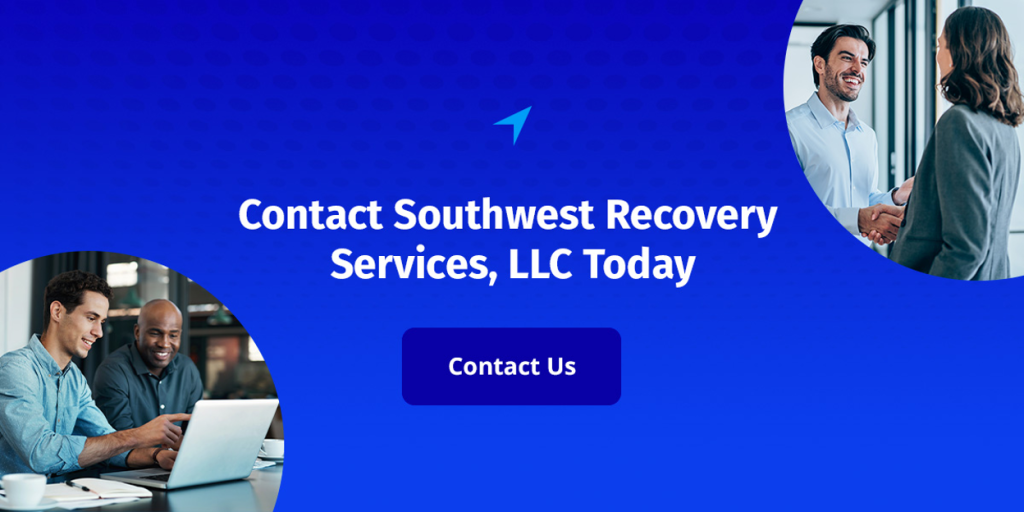- Make A Payment (866) 558-3328
- Client Portal
- Consumer Support

Every business owner knows the frustration: you’ve delivered your product, completed the service, sent the invoice—and now you’re waiting. Days turn into weeks, weeks into months, and that payment still hasn’t arrived. Your working capital is tied up, your cash flow is suffering, and you’re facing a difficult decision about recovering what you’re owed.
Sending an account to collections isn’t anyone’s first choice, but sometimes it’s the only practical path forward. When done correctly with the right partner, the collections process can recover your funds while preserving important business relationships.
|
Southwest Recovery Services: Get Your Money Back 20+ Years Experience | Texas-Based | Contingency Only – You Pay When We Collect
Built for Commercial Collections:
The Southwest Recovery Difference: ✓ Contingency only – no upfront costs ✓ Veteran collectors with respectful omnichannel outreach ✓ Priority sectors: trucking, logistics, contractors, oil & gas ✓ Clear reporting on account status and outcomes Trust & Results You Need: Nationally recognized ethical collections agency with 12 offices across six states. Compliance-first approach with no threats or guarantees. |
Before taking any collection action, confirm the debt is valid and the amount is accurate. You’ll need signed contracts or purchase orders, itemized invoices, delivery confirmations or proof of service completion, and communications about the transaction. Review everything to ensure the amount owed matches what was delivered or performed.
Most late payments are oversights, not intentional. Give your customer the benefit of the doubt with polite reminders. Send a friendly email when an invoice becomes 7–10 days overdue. Keep the tone professional and helpful. Follow up at 30 days past due, then again at 45 days, maintaining a respectful tone while becoming more direct. These early reminders resolve 60–70% of overdue invoices without further escalation.
When email reminders fail, pick up the phone. Phone calls allow you to understand what’s happening: Is there a dispute? Cash flow problems? A lost invoice?
Be prepared to offer solutions. Payment plans can help customers facing temporary difficulties. Early payment discounts might motivate a quick resolution. The goal is to recover your money while keeping the door open for future business.

If reminders and conversations don’t produce results after 60–90 days, formalize your collection efforts with a demand letter.
A demand letter clearly states the amount owed, references the original contract, outlines your legal rights, sets a specific deadline for payment (typically 10–15 business days), and explains consequences if payment isn’t received. The tone should be firm and professional.
Always send demand letters via traceable methods such as certified mail with return receipt or email with read receipt. This documentation proves you made a formal demand, which becomes important if legal action is necessary.
When internal efforts haven’t produced results after 90–120 days, professional help makes financial sense. Look for agencies specializing in commercial collections rather than consumer debt. B2B collections require understanding complex payment terms, industry practices, and relationship preservation.
Verify the agency operates on a contingency basis, meaning you only pay when they successfully recover funds. Confirm they use respectful, professional communication methods rather than aggressive tactics that could damage your reputation.
Prepare a complete file for each account. Provide copies of all original contracts, every invoice related to the debt, proof of delivery or service completion, records of all previous payment reminders and conversations, and any dispute documentation.
Organize everything chronologically. The more organized and thorough your documentation, the higher your recovery rate will be.
Professional agencies implement a structured collection process designed to maximize recovery while maintaining professionalism.
Most reputable B2B agencies use a multi-channel approach over 90–120 days: weekly phone calls at strategic times, professional emails explaining the debt, SMS reminders for tech-savvy contacts, and formal letters for documentation purposes.
The agency tracks every interaction, documents promises to pay, and escalates when necessary. They’ll negotiate payment arrangements, offer settlements for debtors facing financial hardship, and keep you informed throughout. You’ll typically have a dedicated account manager providing regular updates.

After the initial collection period (typically 120 days), the agency evaluates each account’s recovery potential. Promising accounts continue receiving active collection efforts with adjusted strategies.
For accounts with limited response, agencies deploy advanced technologies, including automated dialing systems and skip-tracing services, to locate debtors who have changed contact information. This extended effort can last several additional months.
When all collection efforts are exhausted and the debt amount justifies the expense, legal action becomes the final option.
Professional agencies typically have relationships with attorneys specializing in commercial debt recovery. The legal process begins with filing a lawsuit, which often motivates previously unresponsive debtors to negotiate a settlement.
If the case proceeds to judgment, the creditor can pursue collection through liens on business assets, bank account garnishments, or other legal remedies. Litigation extends the recovery timeline to 6–12 months or longer and adds legal costs, but for significant debts where other methods have failed, it’s often the only remaining path.
Following the right process when sending accounts to collections protects both your revenue and your business relationships. At Southwest Recovery Services, we’ve spent over 20 years perfecting this balance for companies across logistics, freight, oil and gas, contracting, and property management sectors.
Our veteran collectors combine respectful, strategic outreach with proprietary tracking software that ensures every follow-up happens on schedule and no commitment falls through the cracks. This disciplined approach, guided by daily oversight from founder Steven Dietz, recovers your funds without the aggressive tactics that damage future business opportunities.

We operate on a contingency basis, meaning no risk to you, as we only get paid after recovering your money. This performance-based model means that our goals align perfectly with yours: maximum recovery with minimum friction.
Contact Southwest Recovery Services Now
Most businesses wait 60–90 days after an invoice becomes past due before engaging a collection agency. Give internal efforts a fair chance through reminders, calls, and demand letters. However, don’t wait too long because success rates drop significantly after 120 days.
Not necessarily, especially with a professional B2B agency that understands relationship preservation. The agency acts as a neutral third party, separating the financial dispute from ongoing operations. Professional agencies use diplomatic approaches focused on finding solutions, which often preserve future business possibilities.
You’ll need all original contracts or service agreements, itemized invoices, proof of delivery or service completion, records of all previous collection attempts, and any correspondence related to disputes. Organize everything chronologically so the agency can quickly understand the complete history.
Most B2B agencies operate on a contingency fee basis with no upfront costs. You only pay when the agency successfully recovers money. Contingency rates typically range from 15% to 40% of the amount recovered, depending on the age of the debt, total amount owed, and complexity. This performance-based model eliminates financial risk—if nothing is recovered, you owe nothing.
At SWRS, we specialize in B2B commercial debt recovery, and we bring over two decades of experience in trucking, logistics, oil and gas, property management, and contractor services. We operate strictly on a contingency basis, use technology-driven tracking, and maintain founder involvement in daily operations. We provide the professional persistence needed to convert aging receivables into working capital while maintaining your business reputation.


We make it fast and easy to refer past due and delinquent accounts to our professional recovery agents. You decide the range on what you will accept on each case, and you ONLY pay a percentage of what we actually collect to resolve the case. Ready to get started, or want to learn more? Fill out this form and a dedicate account manager will call you to get started.